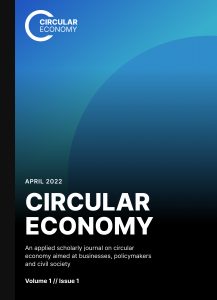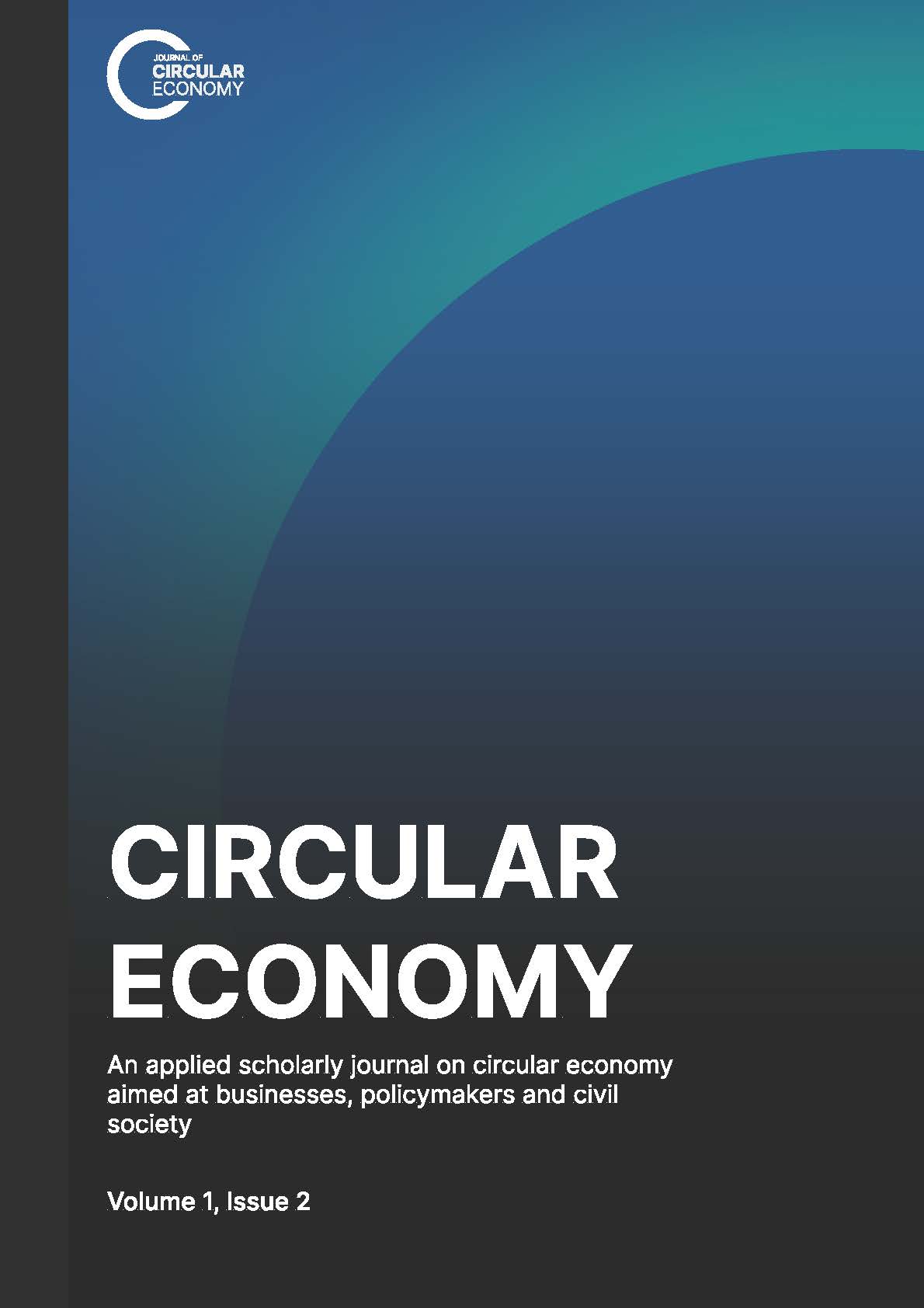Abstract
Keywords
References
Adisorn, T., Tholen, L., & Götz, T. (2021). Towards a Digital Product Passport Fit for Contributing to a Circular Economy. Energies, 14(8), Article 8. https://doi.org/10.3390/en14082289
Aydemir, A. Z., & Jacoby, S. (2022). Architectural design research: Drivers of practice. The Design Journal, 25(4), 657–674. https://doi.org/10.1080/14606925.2022.2081303
Barreto, L., Amaral, A., & Pereira, T. (2017). Industry 4.0 implications in logistics: An overview. Procedia Manufacturing, 13, 1245–1252. https://doi.org/10.1016/j.promfg.2017.09.045
Bocken, N. M. P., de Pauw, I., Bakker, C., & van der Grinten, B. (2016). Product design and business model strategies for a circular economy. Journal of Industrial and Production Engineering, 33(5), 308–320. https://doi.org/10.1080/21681015.2016.1172124
Bucher, D., & Hall, D. (2020). Common Data Environment within the AEC Ecosystem: Moving collaborative platforms beyond the open versus closed dichotomy. EG-ICE 2020 Proceedings: Workshop on Intelligent Computing in Engineering, 491–500. https://doi.org/10.3929/ethz-b-000447240
Bucher, D., & Hall, D. (2022). New Ways of Data Governance for Construction? Decentralized Data Marketplaces as Web3 Concept just around the Corner. Proceedings of the 29th EG-ICE International Workshop on Intelligent Computing in Engineering, 1872. https://doi.org/10.7146/aul.455.c224
buildingSMART International & GS1. (2021). Digitizing construction for better product exchange, identification, and transparency; A buildingSMART International and GS1 Positioning Paper. y buildingSMART International Ltd. https://gs1.se/wp-content/uploads/sites/2/2021/12/digitizingconstruction_whitepaper_gs1_bsi_2021.pdf
Byers, B. S., Cheriyamulla, S., Ewason, J., Hall, D., & De Wolf, C. (2022). Using engraved QR codes to connect building components to materials passports for circular construction. Proceedings of the 2022 European Conference on Computing in Construction, 563–570. https://doi.org/10.35490/ec3.2022.226
Çetin, S., De Wolf, C., & Bocken, N. (2021). Circular Digital Built Environment: An Emerging Framework. Sustainability, 13(11), Article 11. https://doi.org/10.3390/su13116348
Commission, E., & Environment, D.-G. for. (2022). Level(s) and the new European Bauhaus. Publications Office of the European Union. https://doi.org/doi/10.2779/104409
Copeland, S., & Bilec, M. (2020). Buildings as material banks using RFID and building information modeling in a circular economy. Procedia CIRP, 90, 143–147. https://doi.org/10.1016/j.procir.2020.02.122
De Wolf, C., Hoxha, E., & Fivet, C. (2020). Comparison of environmental assessment methods when reusing building components: A case study. Sustainable Cities and Society, 61, 102322. https://doi.org/10.1016/j.scs.2020.102322
Dwaikat, L. N., & Ali, K. N. (2018). Green buildings life cycle cost analysis and life cycle budget development: Practical applications. Journal of Building Engineering, 18, 303–311. https://doi.org/10.1016/j.jobe.2018.03.015
EPEA Nederland BV & SundaHus i Linkoping AB. (2017). Framework for Materials Passports. Buildings as Material Banks (BAMB).
Ghosh, A., Edwards, D. J., & Hosseini, M. R. (2020). Patterns and trends in Internet of Things (IoT) research: Future applications in the construction industry. Engineering, Construction and Architectural Management, 28(2), 457–481. https://doi.org/10.1108/ECAM-04-2020-0271
Gligoric, N., Krco, S., Hakola, L., Vehmas, K., De, S., Moessner, K., Jansson, K., Polenz, I., & van Kranenburg, R. (2019). SmartTags: IoT Product Passport for Circular Economy Based on Printed Sensors and Unique Item-Level Identifiers. Sensors, 19(3), Article 3. https://doi.org/10.3390/s19030586
Global Alliance for Buildings and Construction, International Energy Agency, United Nations, & Environment Programme. (2019). 2019 Global Status Report for Buildings and Construction: Towards a Zero-Emission, Efficient, and Resilient Buildings and Construction Sector (p. 41).
Gordon, M., Batallé, A., De Wolf, C., Sollazzo, A., Dubor, A., & Wang, T. (2023). Automating building element detection for deconstruction planning and material reuse: A case study. Automation in Construction, 146, 104697. https://doi.org/10.1016/j.autcon.2022.104697
Govindan, K., & Hasanagic, M. (2018). A systematic review on drivers, barriers, and practices towards circular economy: A supply chain perspective. International Journal of Production Research, 56(1–2), 278–311. https://doi.org/10.1080/00207543.2017.1402141
Guerra, B. C., Shahi, S., Mollaei, A., Skaf, N., Weber, O., Leite, F., & Haas, C. (2021). Circular economy applications in the construction industry: A global scan of trends and opportunities. Journal of Cleaner Production, 324, 129125. https://doi.org/10.1016/j.jclepro.2021.129125
Honic, M., Kovacic, I., Aschenbrenner, P., & Ragossnig, A. (2021). Material Passports for the end-of-life stage of buildings: Challenges and potentials. Journal of Cleaner Production, 319, 128702. https://doi.org/10.1016/j.jclepro.2021.128702
Honic, M., Kovacic, I., Sibenik, G., & Rechberger, H. (2019). Data- and stakeholder management framework for the implementation of BIM-based Material Passports. Journal of Building Engineering, 23, 341–350. https://doi.org/10.1016/j.jobe.2019.01.017
Iacovidou, E., & Purnell, P. (2016). Mining the physical infrastructure: Opportunities, barriers and interventions in promoting structural components reuse. Science of The Total Environment, 557–558, 791–807. https://doi.org/10.1016/j.scitotenv.2016.03.098
Jansen, M., Gerstenberger, B., Bitter-Krahe, J., Berg, H., Sebestyén, J., & Schneider, J. (2022). Current approaches to the digital product passport for a circular economy: An overview of projects and initiatives (Working Paper No. 198). Wuppertal Papers. https://doi.org/10.48506/opus-8042
Kirchherr, J. (2022). Bullshit in the Sustainability and Transitions Literature: A Provocation. Circular Economy and Sustainability. https://doi.org/10.1007/s43615-022-00175-9
Kirchherr, J., Reike, D., & Hekkert, M. (2017). Conceptualizing the circular economy: An analysis of 114 definitions. Resources, Conservation and Recycling, 127, 221–232. https://doi.org/10.1016/j.resconrec.2017.09.005
Kovacic, I., Honic, M., Sreckovic, M., & Sibenik, G. (2019). Digital Platform for Circular Economy in AEC Industry. 1–15. https://repositum.tuwien.at/handle/20.500.12708/62717
Lee, H. W., Harapanahalli, B. A., Nnaji, C., Kim, J., & Gambatese, J. (2018). Feasibility of using QR Codes in Highway Construction Document Management. Transportation Research Record, 2672(26), 114–123. https://doi.org/10.1177/0361198118776133
Lützkendorf, T. P. (2019). Product data and building assessment – flow of information. IOP Conference Series: Earth and Environmental Science, 225, 012038. https://doi.org/10.1088/1755-1315/225/1/012038
Merezeanu, D. M., & Florea (Ionescu), A. I. (2017). Framework for developing lifecycle management based on IoT and RFID. Journal of Control Engineering and Applied Informatics, 19(1), Article 1.
Montaser, A., & Moselhi, O. (2014). RFID indoor location identification for construction projects. Automation in Construction, 39, 167–179. https://doi.org/10.1016/j.autcon.2013.06.012
Munaro, M. R., Fischer, A. C., Azevedo, N. C., & Tavares, S. F. (2019). Proposal of a building material passport and its application feasibility to the wood frame constructive system in Brazil. IOP Conference Series: Earth and Environmental Science, 225, 012018. https://doi.org/10.1088/1755-1315/225/1/012018
Ness, D., Kim, K., Swift, J., Jenkins, A., Xing, K., & Roach, N. (2020). Cradle to Cradle Building Components Via the Cloud: A Case Study. In R. Roggema & A. Roggema (Eds.), Smart and Sustainable Cities and Buildings (pp. 593–604). Springer International Publishing. https://doi.org/10.1007/978-3-030-37635-2_40
Panko, R. R. (2008). Spreadsheet Errors: What We Know. What We Think We Can Do (arXiv:0802.3457). arXiv. https://doi.org/10.48550/arXiv.0802.3457
Pollok, I., Temple, B. K., Edgar, D. A., Harrison, D. K., & Kinzler, S. C. (2004). The International Material Data System: Global Data Collection for the End-of-life Vehicle Management. In S. Hinduja (Ed.), Proceedings of the 34th International MATADOR Conference (pp. 385–392). Springer. https://doi.org/10.1007/978-1-4471-0647-0_57
Shiji Cheriyamulla. (2022). Application of lean management principles to the data management of building materials for reuse [Master]. ETH Zurich.
Soman, R. K., Kedir, F. N., & Hall, D. M. (2022). Towards circular cities: Directions for a material passport ontology. 3, 0–0. https://doi.org/10.35490/EC3.2022.212
Stahel, W. R. (2016). The circular economy. Nature, 531(7595), Article 7595. https://doi.org/10.1038/531435a
Swift, J., Ness, D., Kim, K. P., Gelder, J., Jenkins, A., & Xing, K. (2017, September 5). Towards Adaptable and Reusable Building Elements: Harnessing the Versatility of the Construction Database Through RFID and BIM.
Tang, S., Shelden, D. R., Eastman, C. M., Pishdad-Bozorgi, P., & Gao, X. (2019). A review of building information modeling (BIM) and the internet of things (IoT) devices integration: Present status and future trends. Automation in Construction, 101, 127–139. https://doi.org/10.1016/j.autcon.2019.01.020
Tim Berners-Lee. (2009, June 18). Linked Data—Design Issues. Linked Data. https://www.w3.org/DesignIssues/LinkedData.html
Torgautov, B., Zhanabayev, A., Tleuken, A., Turkyilmaz, A., Mustafa, M., & Karaca, F. (2021). Circular Economy: Challenges and Opportunities in the Construction Sector of Kazakhstan. Buildings, 11(11), Article 11. https://doi.org/10.3390/buildings11110501
Valero, E., Adán, A., & Cerrada, C. (2015). Evolution of RFID Applications in Construction: A Literature Review. Sensors, 15(7), Article 7. https://doi.org/10.3390/s150715988
van Groesen, W., & Pauwels, P. (2022). Tracking prefabricated assets and compliance using quick response (QR) codes, blockchain and smart contract technology. Automation in Construction, 141, 104420. https://doi.org/10.1016/j.autcon.2022.104420
Ventura, C. E. H., Aroca, R. V., Antonialli, A. Í. S., Abrão, A. M., Rubio, J. C. C., & Câmara, M. A. (2016). Towards Part Lifetime Traceability Using Machined Quick Response Codes. Procedia Technology, 26, 89–96. https://doi.org/10.1016/j.protcy.2016.08.013
Wijewickrama, M. K. C. S., Rameezdeen, R., & Chileshe, N. (2021). Information brokerage for circular economy in the construction industry: A systematic literature review. Journal of Cleaner Production, 313, 127938. https://doi.org/10.1016/j.jclepro.2021.127938
Williams, J. (2022). Challenges to implementing circular development – lessons from London. International Journal of Urban Sustainable Development, 14(1), 287–303. https://doi.org/10.1080/19463138.2022.2103822
WorldGBC & Ramboll. (2019). Bringing embodied carbon upfront—Coordinated action for the building and construction sector to tackle embodied carbon (p. 35). World Green Building Council.
Yin, R. K. (2013). Case Study Research: Design and Methods (5th ed.). SAGE Publications.


